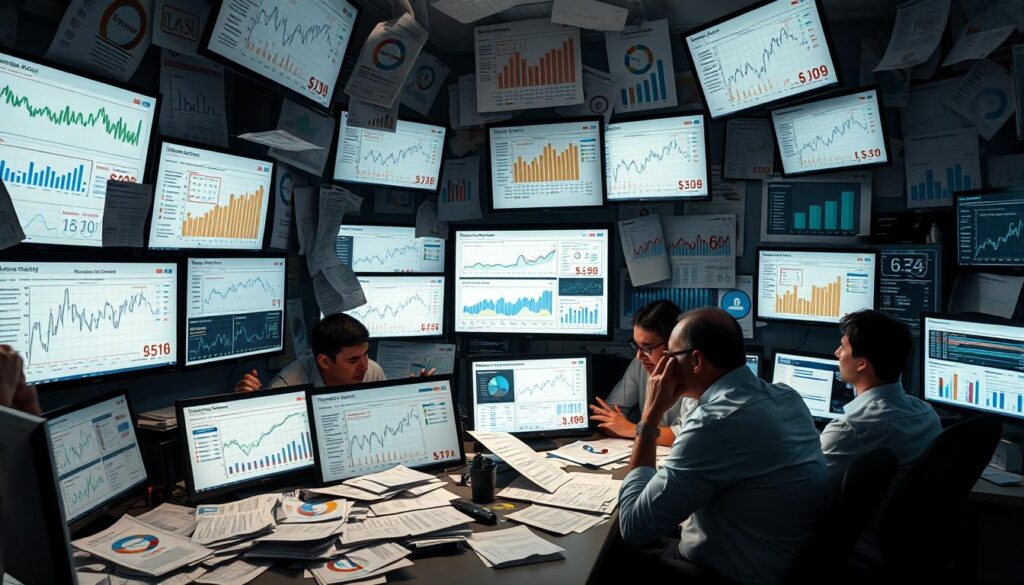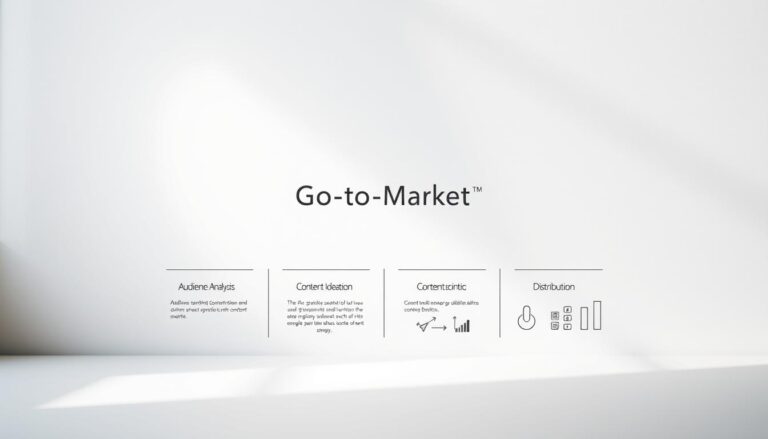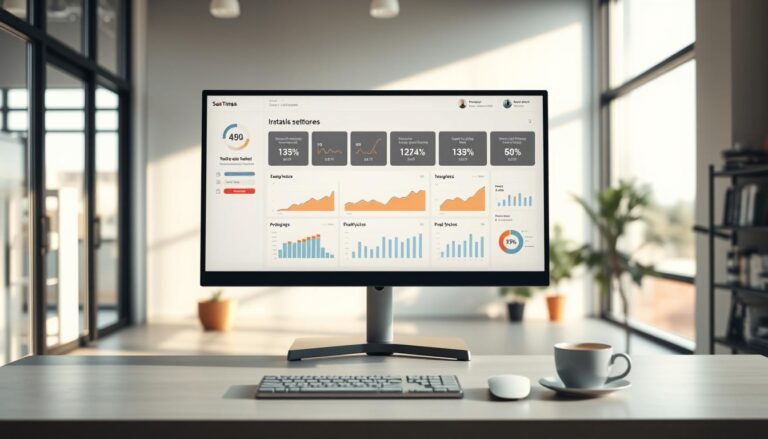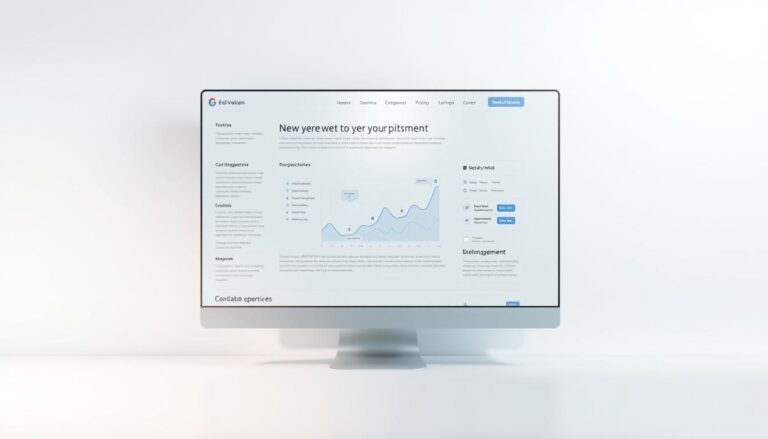The introduction of intelligent sales data visualization has changed how we view sales data. It aims to turn complex data sets into easy-to-understand visuals. These tools are more than just ways to show data—they help make big business decisions.
They provide clear insights from tough data quickly, leading to smarter choices. This helps organizations understand their sales better and make informed decisions.
Companies can easily see sales trends and find areas to improve with these visuals. The use of intelligent sales data visualization spans different sales aspects. It combines the look and usefulness of data, crucial in today’s fast-changing business world.
Want more details on how to boost your revenue? Check out our guide on sales intelligence and its importance today.
Good visualization guides sales teams on what to focus on. It helps predict market needs, manage stock, and set the right prices. All these lead to more profit and happy customers.
Key Takeaways
- Visual data tools promote accurate forecasting for improved resource and inventory control.
- Timely visualization aids in recognizing and addressing weak points in product or service offerings.
- KPI visuals enhance sales team accountability, spurring performance and increasing revenue.
- Data-driven custom sales strategies lead to better customer retention and higher revenue.
- Intelligence from visual sales data ensures agile responses to market shifts, securing competitive advantage.
Understanding Intelligent Sales Data Visualization
In our data-focused world, mastering advanced data visualization is key for sales teams to excel. This innovative method makes complex data easy to understand. It also changes the way companies use their data.
Definition and Importance
Intelligent sales data visualization uses graphics to present sales information clearly and usefully. With sales reporting software, businesses can find visual sales insights hidden in raw data. This improves decision-making speed and accuracy, especially when markets change quickly.
Key Features and Benefits
Intelligent sales data visualization excels in making data understandable intuitively. Companies that adopt this see many advantages:
- Quicker decisions through real-time data analytics
- Better forecasting thanks to enhanced predictive sales analytics
- Targeted strategies from deep sales performance analysis
- Improved teamwork, creating a unified work environment
Using sales reporting software for visual sales insights aligns everyone from sales to leadership. Everyone understands the company’s goals and the market situation.
Tools like Tableau and Power BI streamline work and boost sales metrics. Firms using these tools see more revenue, productivity, and efficiency.
Stats show the impact of these technologies:
- Using advanced data visualization tools leads to 28% more info pulled from data.
- A 28% increase in B2B sales revenue when data visualization is used well.
- Data-driven decisions become five times faster, tripling execution speed.
Adopting these tools builds a culture focused on data. It helps companies become leaders in their industry. Proper use reveals trends and opportunities that are hard to see with old analysis methods.
The Role of Data Visualization in Sales Strategy
Sales analytics and real-time sales data visualization tools are key for businesses today. They turn complex data into simple dashboards and reports. This makes it easier for companies to make smart decisions and predict future trends accurately.
Improving Decision-Making Processes
For sales to succeed, clear and available data is crucial. Interactive sales analysis lets managers see how they’re doing and change plans quickly. This fast access to data helps react rapidly to new challenges or performance issues.
Studies show that decision-making speeds up with visual data. It’s important for both minor tweaks and major strategic shifts. Being quick can help a business take advantage of new chances or avoid problems.
Enhancing Sales Forecasting Accuracy
Getting sales forecasts right is critical for planning and using resources wisely. By using sales analytics shown in charts and graphs, companies can better predict trends and customer actions. Data shows that visualization improves sales forecast accuracy, clearly demonstrating its impact.
This improvement in forecasting, aided by new visual tools, boosts efficiency across the company. It helps in planning production, finances, and marketing efforts, leading to better performance and profits.

| Metric | Value | Impact on Sales Strategy |
|---|---|---|
| Speed of decision-making increase | Percentage increase | Quick adaptation to market dynamics |
| Sales forecasting accuracy ratio | Improvement ratio | Enhanced strategic planning |
| Accountability in sales reps | Percentage increase | Higher performance and goal alignment |
| Frequency of data sharing | Frequency rate | Improved cross-functional collaboration |
| Customer insights enhancement ratio | Enhancement ratio | Better customer targeting and retention strategies |
In the end, using sales analytics with real-time visualization makes data easier to understand. It greatly improves the accuracy of sales strategies and operations in companies.
Types of Data Visualizations for Sales
In the realm of sales, using data visualization tools is key for big improvements. We explore various visuals that help businesses study sales data, improve interactive sales analysis, and up their game.
Charts and Graphs
Charts and graphs are core for simplifying complex data. Line graphs show trends over time, helping predict future sales. Bar charts compare different products or sales teams over certain times.
Funnel charts, or pipeline visualization, show how customers move through sales stages.
Dashboards and Heat Maps
Dashboards merge different data views, including KPIs, into one easy interface. This helps make quick decisions and makes work smoother. Heat maps shine in showing complex data like area sales, quickly pointing out top and bottom performers.
Here’s a comparison of different visual types and how they’re used in sales:
| Visualization Type | Main Use in Sales | Benefits |
|---|---|---|
| Bar Chart | Comparing different groups | Clear visual differentiation between categories |
| Line Graph | Trend analysis over time | Identifies rise and fall patterns |
| Funnel Chart | Tracking conversion rates | Visualizes progression through sales stages |
| Heat Map | Regional performance analysis | Highlights areas of high and low activity |
| Dashboard | Centralized data monitoring | Consolidates multiple data sources for quick review |
Using different data visualization tools boosts the sales process, strategic decision-making, and company growth through interactive sales analysis.
Best Practices for Implementing Sales Data Visualization
Implementing sales data visualization well involves a few key steps. These include picking the right data visualization tools and integrating them smoothly with what you already have. Doing this right helps companies improve their sales and understand their data better.
Choosing the Right Tools
It’s vital to pick the best data visualization tools. These tools should turn complex data into easy-to-understand visuals. Sales performance dashboards and other tools must be powerful and fit with your tech and data needs. Tableau, Power BI, and Google Data Studio are great choices. They can handle big data, update in real-time, and work with many file types.
Integrating with Existing Systems
Integrating new tools with your current systems should be smooth. This keeps things running well and uses your existing data. Make sure new tools work with your CRM systems. This keeps data flowing freely and safely.
When designing sales dashboards, focus on simple designs that speak to the user. Use clear labels and simple colors to keep things clear and easy to read. This helps everyone understand the data quickly.
| Type of Visualization | Main Benefit | Suggested Use |
|---|---|---|
| Scatter Plot | Shows data correlation | Analyze sales performance variables |
| Line Chart | Displays trends over time | Track sales growth or decline |
| Donut Chart | Represents proportions | Show sales distribution by category |
| Bar Chart | Compares quantities | Compare sales across different regions |
To make sales data visualization work best, match the visuals to the audience’s needs. Make sure the data is clear and easy to approach. Adding features like drill-downs and tooltips makes exploring the data more interactive.
Case Studies: Success Stories in Sales Visualization
Real-world examples show how advanced data visualization greatly helps businesses. Companies in various industries have seen big improvements in efficiency and profits by using this tech. We will look at how visual sales insights and sales analytics have shaped corporate strategies.
Industry Leaders Leveraging Data Visualization
Many sectors have changed for the better with advanced data visualization tools. For example, Meijer improved its sales analysis and managed inventory better. Metro Bank used Power BI to get more accurate financial reports. Similarly, Cleaver Fulton Rankin made faster decisions in the legal field. These changes have made operations more efficient and helped in making better strategy decisions.
Measurable Outcomes and ROI
Using advanced data visualization tools has led to more profits and better efficiency. Los Angeles Public Works saw a 40% rise in community involvement with better data strategies. Chevron in the energy field cut costs and worked more efficiently. This shows the real financial gains from using smart sales analytics tools.
| Company | Sector | Improvement Noted | Tool Used |
|---|---|---|---|
| Pfizer Pharmaceuticals | Healthcare | Quicker drug development | Power BI |
| Renault | Manufacturing | Increased production efficiency | Advanced Visualization Software |
| Heathrow Airport | Transportation | Optimized operations, reduced wait times | Real-time Analytics Tools |
| University of Phoenix | Education | Improved student performance tracking | Power BI |
| AT&T | Telecommunications | Enhanced network performance | Power BI |
The case studies show that advanced data visualization does more than make reports look good. It leads to a culture focused on data, where strategic choices are improved by visual sales insights. This approach drives businesses towards greater success today.
Common Challenges in Sales Data Visualization
In the world of intelligent sales data visualization, several challenges can lower the effectiveness of strategies. These challenges, like having too much data and misunderstanding it, greatly affect how well visual analytics work. To make the most out of data visualization tools, a comprehensive understanding and strategy are required.
Data Overload

Data overload happens when there’s too much info, making decisions hard. A study by Harvard Business Review showed that managing sales pipelines well could result in a 28% increase in revenue growth. Success hinges on sorting and prioritizing key sales data accurately.
To tackle this issue, data visualization tools offer filters and data interaction features. These allow users to concentrate on important info. Non-essential data can be hidden for a deeper interactive sales analysis.
Misinterpretation of Information
Misreading data can cause wrong strategic moves and missed chances. Ups and downs in sales might not reflect true causes due to unreliable data. This leads to decisions that might harm revenue.
Tools like Zoho CRM, Tableau, and Microsoft Power BI have features to fix and clarify data. Their Cluster and Merge functions help correct errors. This provides clearer visual insights.
| Challenge | Tool Feature | Benefit |
|---|---|---|
| Data Overload | Data Filtration & Interaction | Enhances focus on critical metrics |
| Misinterpretation | Cluster and Merge Functions | Corrects data inaccuracies |
Intelligent sales data visualization faces obstacles, but smart use of BI tools can lessen them. For sales stakeholders, picking suitable data visualization tools is crucial. It opens up streamlined, insightful visual data experiences. This aids in making the best strategic decisions.
Future Trends in Sales Data Visualization
As we move through the digital age, sales data visualization is changing fast. Cutting-edge tech and new methods are making old tools outdated. The use of advanced business intelligence in sales reporting is essential. It lets us use real-time sales data visualization better.
AI and Machine Learning Integration
AI (Artificial Intelligence) and ML (Machine Learning) will change real-time sales data visualization. AI can automate data analysis and offer predictions for strategic planning. This means businesses could soon predict market trends and customer behavior accurately and reliably.
- Artificial datasets made by GANs and VAEs reduce privacy worries and boost model training.
- Machine learning gives fresh insights into consumer behavior, letting sales teams quickly adjust to new trends.
Increased Focus on Customization
Customization is now key in sales reporting software. It means data visualization is made to fit each business’s needs perfectly. This helps in understanding complex data better, making decision-making easier.
- Interactive tools let users explore data on their own, without special training.
- With more types of data being analyzed, having a clear view of trends is critical. This need is met by advanced customization tools.
Looking ahead, these advances in software and solutions are game-changers, not just updates. Real-time data visualization, powered by AI and tailored platforms, is becoming essential. It’s going to be a main driver for businesses in the digital era.
Conclusion: Maximizing Your Revenue Potential
Our talks on smart sales data visuals have shown its key role for businesses. It’s not just an extra but a need for better decisions and higher sales. By turning detailed data into easy-to-understand stories, these insights help teams see trends, check progress, and fine-tune plans. Firms using sales dashboards significantly boost their B2B relations and customer interactions. They rely on live data to create lasting, profitable bonds.
Final Thoughts on Intelligent Sales Data Visualization
In exploring B2B data visuals, we dig into more than just showing data. It’s about changing how firms see customer actions, sales, and important metrics. Tools like Tableau and Domo lead the field, letting companies blend insights with CRM systems like Salesforce and HubSpot. This boosts sales methods and leads to more efficiency and profit. The numbers tell it all: sales up by 20%, customer churn down by 15%, and marketing effectiveness up by 25%. All these within months show how game-changing this tech can be.
Call to Action for Engagement
As we wrap up on smart sales data visuals, let’s remember the goal. It’s not just about understanding but also about doing. Start using the latest tools, explore the data, and find the insights to drive your business ahead. With a smart view on visual sales insights and a zest for new ideas, your business can thrive in today’s data-oriented world. Sales’ future is bright and visual. So, are you set to take a closer look?
FAQ
What is intelligent sales data visualization?
Intelligent sales data visualization uses visuals like charts and dashboards to show sales data. This makes complex data simple to understand. It helps sales teams make fast, informed choices.
Why is intelligent sales data visualization important for businesses?
It lets companies see trends, measure how they’re doing, and find chances to get better. Seeing data this way leads to faster decisions, better predictions, and more sales.
What types of data visualizations are commonly used in sales?
Sales people use many visuals, like bar charts and pie charts. Also dashboards and heat maps. Each one helps in different ways, from showing trends to tracking sales deals.
How does real-time sales data visualization impact decision-making?
With real-time data, managers can see what’s happening right away. They can fix problems fast and change plans as needed. This can greatly help sales.
What best practices should be followed for implementing sales data visualization effectively?
Good practices include focusing on important numbers and keeping visuals simple. Choose tools that work well with your sales system. Update data often and make sure visuals speak to your audience.
Can you provide examples of industry leaders benefiting from sales data visualization?
Many top companies use advanced visuals and analytics in their sales. They have seen better revenue, efficiency, and forecasting. This helps them compete better.
What are common challenges faced with sales data visualization?
Too much data can be overwhelming and confusing. There’s also a risk of reading the visuals wrong, leading to mistakes. Picking the right data to show is key.
How will AI and machine learning shape the future of sales data visualization?
AI and machine learning will make data visuals even sharper. They’ll predict trends and give specific tips. This means even better visuals for making decisions.
What steps should my organization take to maximize revenue using intelligent sales data visualization?
To boost revenue, dive into the latest data tools that match your business size and needs. Keep up with trends and sharpen your visual strategies for better results.



